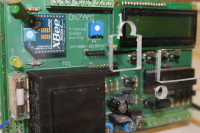Home Automation with XBee modules

The goal of this domotica project is to create a wireless home automation project using ZigBee protocol with XBee modules as radio and Pic as microcontroller and Raspberry-Pi als controlling and logging inteligence.
The goal of this domotica project is to create a wireless home automation project using ZigBee protocol with XBee modules as radio and Pic as microcontroller and Raspberry-Pi als controlling and logging inteligence.
- First stage is to construct a 4-channel light switch/Dimmer system. Containing a 4-channel triac dimmer/switch board, a controller for the dimmer board and a remote control for commanding all the nice.
- Second stage is a automated door for the chicken house to protect them agains nightly visits of the foxes.
- Thirth stage is an individual on/of swicht powered on 240V and so small it fits in a normal wall-switch-box And many many other things.....
I will be adding the developement of the project in separate contributions so that the the readability will bee better.
Contributions: (attention contributions in reverse order)
- 1.1. The triac dimmer/switch principe (17/05/2013)
- 1.2. The triac dimmer/switch Practical realization. (18/05/2013)
- 1.3. How a dimmer works (27/05/2013)
.
- 2.1. Zero-pass-detection (21/06/2013)
Comming soon:
- 2.2. Phase-control with the PIC-18
To be continued soon.....



Discussion (4 comments)